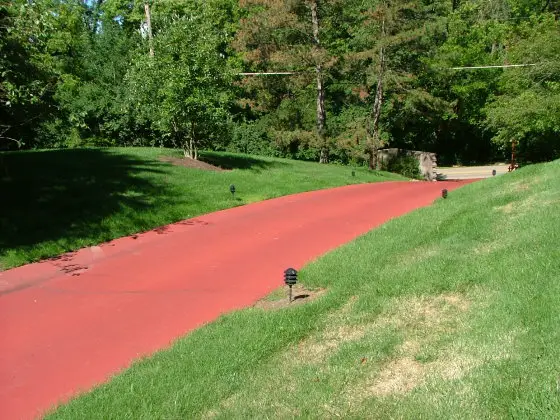Wide Variety of Blacktop Sealers

Blacktop Sealer | Your monitor is fine. This is a red blacktop driveway sealer applied by a professional driveway sealing company. Not only do they seal driveways, but they also seal tennis courts on a regular basis. Start thinking outside the box if you want something other than a black driveway. Photo Credit: Tim Carter
Best Blacktop Sealing Checklist - Get Mine and Hire the Pro
DEAR TIM: My asphalt driveway has seen better days. The original deep-black asphalt surface is now gray and the drive has several cracks in it. The surface is not in bad shape. What is the best sealer for the money? What do I have to do to achieve professional results? When is the best time to apply asphalt sealer? Bobbie S., Lolo, MT
DEAR BOBBIE: It sounds to me as if you have captured the perfect moment to save your asphalt drive surface. Of course, if you were from the East coast, I would have said hot top drive, and had you been from the Midwest, I would have mentioned blacktop. It is fascinating how the same paving material is called different names by different people. No matter what you call it, the process to preserve and maintain it is the same.
What are the types of asphalt sealers?
There are two basic asphalt sealer products. One is a simple asphalt emulsion where regular asphalt is suspended in water. Water-based asphalt sealers are earth-friendly as they do not cause ozone pollution. Perhaps the most popular asphalt sealer is a coal tar-based product. Coal tar is a by-product distillate when coal is made into coke for the steel industry.
Do You Want the BEST Contractor to Seal Your Blacktop?
Go Here and Get my Ask the Builder Blacktop Sealing Checklist!
It's GUARANTEED to help you Hire the BEST CONTRACTOR.
What are the advantages of coal tar asphalt sealers?
Coal tar asphalt sealers have many advantages over their asphalt competitors. For one, they have built-in ultraviolet stabilizers, and as such, they stay blacker much longer than an asphalt-based sealer. Coal tar sealers are chemically different from asphalt, and this difference allows them to resist damage from spilled gasoline, oil, brake, and transmission fluids. These fluids can rapidly eat away at asphalt drives and sealers.
How do you apply asphalt sealers?
To obtain professional results when applying asphalt sealers, you need to do many things. Patience is the first thing you need to pull out of your toolbox. The preparation work can often stretch over several days and possibly a week. The driveway surface must be cleaned. You must remove all fine dirt, silt, mud, oil and any foreign material. You can pressure wash the surface, so long as you do not use so much force as to erode the asphalt surface. Pressure washers are excellent tools to deep clean cracks in asphalt drives.
Once the cracks are clean and dry, you can begin to fill them. Follow the instructions on the label of the crack filling products. Deep and wide cracks will probably need two applications as the material often shrinks as it dries. Many crack fillers insist that their products are thoroughly dry before you apply a coat of sealer. It may take several days for the crack filler to become sufficiently hard so that it can be coated with sealer.
What is the best sealer to purchase?
If you purchase a high-quality sealer, you will not have to struggle to mix it. Most modern, high-quality sealers are formulated as no-stir or easy-stir. It is important to make sure the product is mixed well and homogeneous if you want consistent color results. Your neighbors will know if you slack off when mixing any asphalt sealer. Failure to mix well results in a blotchy appearance with different shades of black. Low cost and quality sealers must be stirred very well as the resins separate from the water.
You should buy one of the highest-priced products since you are a person who lets their driveway sealer wear until the blacktop turns gray. Some people prefer to have a jet-black driveway each season. These people should use low-cost sealers that wear quickly. It is a huge mistake to install top-quality sealers each year. Doing so creates layers of sealer that can actually peel over time.
When is the best time to apply an asphalt sealer?
The best time of year to apply asphalt sealer is when the weather is warm to hot. All too often, people procrastinate and wait until fall to seal their asphalt driveways. Virtually every sealer tells you to avoid applying it if the outside temperature drops below 50 F during the application and drying phase. It simply makes better sense to avoid brushing up against this low temperature. I recommend that you get busy right now while the summer sun is high in the sky.